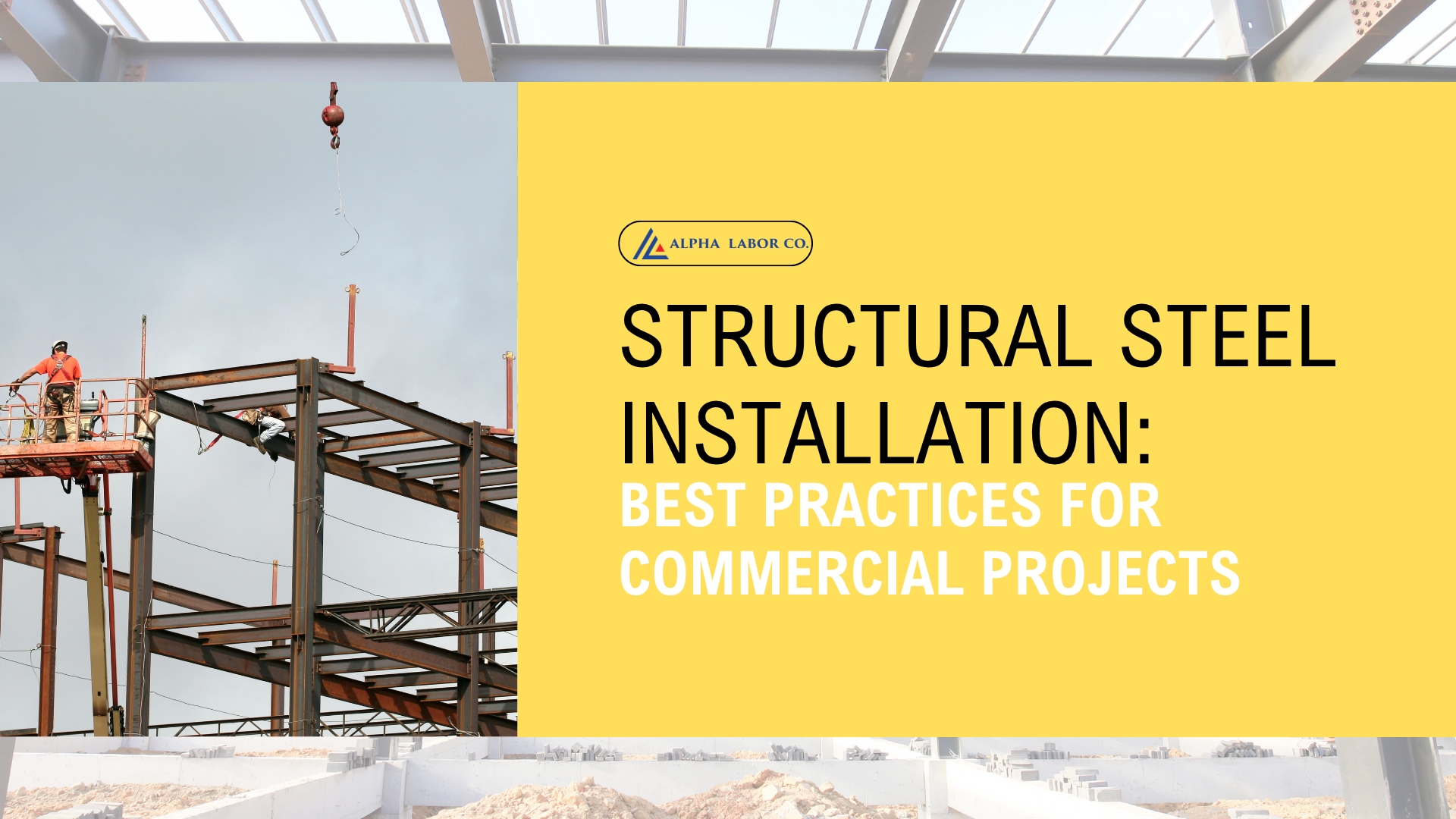
Structural Steel Installation: Best Practices for Commercial Projects
Structural steel is the backbone of modern commercial construction.
But while the material itself is impressive, it takes expert labor and precise execution to ensure structural steel installation is done safely and correctly. Mistakes can lead to severe safety incidents, project delays, and costly rework.
For GCs and project managers PMs, understanding what goes into a successful steel install—and partnering with the right crews—is critical.
Here’s what you need to know.

Why Pre-Engineered Metal Buildings Are Dominating Commercial Construction in 2025
Commercial construction is evolving fast in 2025, and speed is everything. General contractors and developers are under pressure to deliver commercial buildings quickly and more affordably without sacrificing quality or safety. As traditional construction struggles to keep up, one solution is pulling ahead: pre-engineered metal buildings (PEMBs).
With their ability to accelerate timelines, reduce costs, and scale efficiently, PEMBs are a popular choice in the construction industry this year.
Discover how PEMBs are emerging as the go-to solution for commercial development and dominating the market.

Construction Staffing for Metal Building Erection: What GCs Should Know
Multi-phase steel builds require specialized crews for every step, from pouring foundations to flying steel to finishing interiors. Yet, too many general contractors struggle with labor gaps, uncoordinated crews, or subcontractor delays that ripple across the timeline.
The solution? A staffing strategy built around the construction process, with a partner like Alpha Labor Co. that delivers phase-aligned, safety-first labor at every stage.
Here’s how GCs and project managers can use construction staffing and keep metal building projects moving smoothly from start to finish.

Top Reasons to Outsource Your Construction Labor Solutions
As projects grow more complex and timelines tighten, outsourcing construction labor has become a smart, strategic move for many construction companies.
Instead of managing full-time crews across multiple sites, forward-thinking project managers and GCs are turning to partners like Alpha Labor Co. to get reliable, safety-first labor solutions that scale with their needs.
Here’s why outsourcing your construction labor solutions can make all the difference.

Spring Construction: How to Improve Construction Productivity
Spring is go-time for the construction industry. Job sites are opening up, timelines are tightening, and expectations are high.
For project managers and contractors, the pressure is on: improve construction productivity or risk falling behind.
With the right strategies—and the right labor partner—you can turn spring into a season of high-efficiency, safe, and successful builds.

How to Choose the Right Construction Labor Contractor for Your Project
The labor contractor you choose can make or break your timeline, budget, and—most importantly—safety record. Whether you're tackling a metal building installation, structural steel erection, or a concrete-intensive build, finding the right partner is essential.
Discover how to choose the right construction labor contractor that caters to your project's needs.

Top Construction Certifications Every Crew Should Have on Your Job Site
On any job site, one overlooked credential can cost time, money, and — most importantly — safety. Construction certifications aren’t just a line on a resume. They’re proof that a crew knows how to work safely, efficiently, and in compliance with construction industry standards.
Every crew Alpha Labor Co. deploys come trained and certified to meet the toughest demands — from project management to PEMB assembly and steel erection to concrete pours.

Mastering Construction Crew Management: Best Practices for 2025
Whether you’re leading a pre-engineered metal building (PEMB) job in Texas or managing a concrete pour in the Midwest, construction crew management is the linchpin of site success. It impacts safety, timelines, budget, and quality — all in real time.
Here’s how to sharpen your crew management strategy in 2025.

What to Expect During Pre-Engineered Metal Building Installation
Pre-engineered metal buildings (PEMBs) are one of the most efficient and cost-effective options for commercial and industrial construction today.
But just like any construction project, success hinges on the process — and knowing what to expect during installation helps you stay on time, on budget, and aligned with project goals.
Here’s how it works.

The Cost Advantages of Pre-Engineered Metal Buildings
In commercial construction, cost-efficiency is never just about materials—it's about the lifecycle of the building.
Pre-engineered metal buildings (PEMBs) are smart, cost-effective solutions for developers needing durable, high-performing facilities without budget overruns.
Here's a breakdown of the cost of pre-engineered metal buildings, how they reduce overall construction costs, and how you can maximize savings on your next construction project.

Common Metal Building Erection Mistakes & How to Avoid Them
Precision is crucial in metal building erection. Even minor errors can lead to delays, cost overruns, and safety hazards. Understanding and avoiding common mistakes ensures a smoother construction process and a structurally sound final product.
Alpha Labor Co. specializes in efficient and accurate pre-engineered metal building erection, helping prevent issues before they arise.
We'll walk you through the most common metal building erection mistakes and how to avoid them.

Embracing Sustainable Innovations in Metal Building Design
Traditional methods are often characterized by high carbon footprints and waste. Today, the demand for sustainable construction is transforming the metal building industry. Construction trends are giving way to eco-friendly innovations that promote efficiency and long-term value. These designs showcase the versatility of metal buildings without sacrificing structural integrity.
As construction industry expectations evolve, Alpha Labor Co. stands at the forefront, integrating cutting-edge sustainable practices into every project.

Concrete Construction Staffing: Why Specialized Crews Are Crucial for Concrete Projects
Large-scale concrete projects require experienced professionals who understand the complexities of pouring, forming, and finishing concrete under demanding conditions.
Explore our in-depth guide on how specialized concrete staffing enhances efficiency, improves project timelines, and ensures structural integrity.

Comparing Pre-Engineered Metal Buildings vs. Conventional Steel Construction
When it comes to large-scale industrial and commercial construction, choosing between Pre-Engineered Metal Buildings (PEMBs) and Conventional Steel Construction can significantly impact cost, timeline, and long-term maintenance. Both methods have distinct advantages depending on project scope, budget, and site conditions.

Fireproofing Techniques for Structural Steel in High-Risk Areas
Structural steel is a popular choice for modern construction due to its strength, durability, and flexibility. However, it has one critical weakness: vulnerability to high temperatures. At approximately 1,000°F (538°C), steel loses half of its strength, risking structural failure during fires. In high-risk areas—such as industrial zones, chemical plants, and regions prone to wildfires—fireproofing is essential.

How Self-Healing Concrete Could Revolutionize Urban Development
Urban infrastructure faces continuous stress from traffic, extreme weather, and time. Traditional concrete, while strong, develops cracks over time, leading to costly repairs, road closures, and weakened structures.
Enter self-healing concrete, a revolutionary material designed to repair its own cracks, significantly extending the lifespan of roads, bridges, and buildings. With global infrastructure spending reaching $3.8 trillion annually, self-healing concrete presents a game-changing solution for cost savings and sustainability.

The Impact of Early Labor Resource Planning on Construction Success
Labor shortages, scheduling conflicts, and inefficiencies plague the construction industry, often leading to project delays and budget overruns. According to a 2023 AGC report, 80% of construction firms struggle with workforce shortages, making early labor resource planning more crucial than ever.

How to Reduce Waste and Improve Efficiency on Your Construction Site
The construction industry is notorious for waste and inefficiency. Studies show that 30% of all construction materials delivered to a site end up as waste, adding unnecessary costs and environmental impact. At the same time, poor planning, material mismanagement, and inefficient labor allocation lead to delays and budget overruns.

How to Choose and Manage Concrete Finishers Effectively
Choosing and managing concrete finishers effectively involves evaluating their skills, recruiting wisely, managing them efficiently, and ensuring quality and timeliness throughout the project. Your approach will significantly impact the final outcome. From identifying the right skill set to employing structured management techniques, every step contributes to delivering top-notch results. Quality checks and prompt scheduling play crucial roles in achieving successful concrete outcomes.

Innovative Techniques for Structural Steel Installations
The structural steel industry continues to evolve with new technologies and methods that enhance every aspect of construction. From the accuracy brought by drones and laser scanning to the safety ensured by modern gear and training, these improvements make sites more productive and safer for everyone involved. Innovations like prefabrication and sustainable practices further emphasize the industry's commitment to efficient and eco-friendly solutions.

